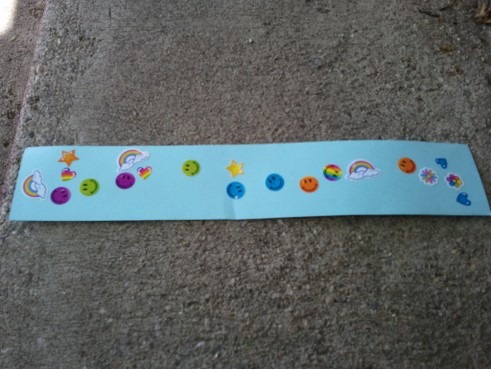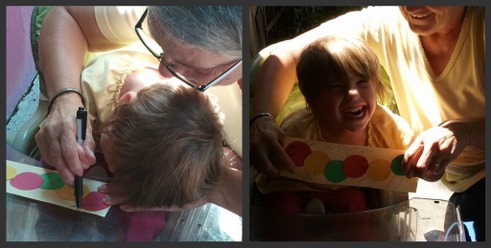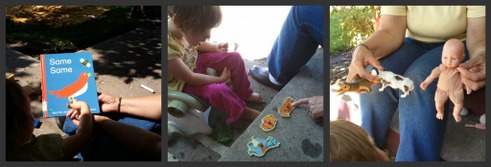One more math article!!!! Here is what happened. I go to the library once a month and get the books to cover four weeks worth of topics. Well, the last time I went I found so many fabulous math and pre-math books that I just couldn’t resist. Out of that one set of books we have had three math weeks – Teaching children Geometry and Math through Shapes, Basic Math Concepts and Ideas for Preschoolers, and now Mathematical Reasoning Skills.
This week we focused on activities to teach patterns and same/different. I could have split patterns and same and different into two weeks but it is time to move on and return to math in a few weeks or months.
It is very important to children’s mathematical reasoning abilities to be able to classify objects or describe positions and patterns. When they can do this they are learning to make logical decisions that organize their world. They have to notice different objects properties or attributes and then make decisions based on them. You can assist in developing childrens awareness of patterns by helping them look for them in their world. Patterns are commonly found in nature and in things that people make. Developing children’s awareness of patterns is vital.
On this day I didn’t have any good books on patterns for very small children so we just made up our own activities to see and talk about patterns. However, I did find a fabulous book on patterns for older children (ages 8-13) which show fibonacci numbers (see below). I myself had never been able to understand this pattern and this book made it soooo easy!
We began by making patterns with long colored craft sticks. Maggie who is 5 loved this activity and really liked picking which stick came next. Jack was not very interested in the whole thing and I discovered why and will share it a bit later.
Next we used some colorful and varied stickers in a line to make a pattern on a long piece of paper. Jack wasn’t able to make a line but was putting all his stickers on one end in a clump. As Maggie and I worked on our pattern Jack began to notice what I meant when I said put them in a straight line. You can see from the picture below that he then was able to make a pretty straight line – that is until he ran out of space and was determined to keep adding stickers!
That is why Jack wasn’t interested in patterns. He is not ready for it. He still needs to learn concepts such as a straight line, making a curve, etc. which are also important for good mathematical reasoning. So we will revisit patterns many times this year and also more basic concepts while Jack learns.
We finished our section on patterns by making a caterpillar out of colored circles. As always everyone loves using glue!
Then we focused on same and different. We made selections based on color, shape and size, etc. I asked a lot of questions such as ‘How are these two objects the same? How are they different? What’s another way they are the same? How else are they different?’ Sometimes children may think that only one answer applies to “same and different” situations. I modeled my own reasoning, showing several ways the objects were the same and different.
We began with items that were all the same but different colors and separated them by color. We used large wooden beads, jacks and beans. The most exciting part of this for Jack was discovering that jacks had his name. They were a Jack and he was a Jack!
Jack was better able to do this type of simple sorting than he had been at patterns.
Next we used items that were all different colors and shapes (shape blocks) and separated them by shape. So now we might have a blue triangle, a red one and a green one in the same pile. Maggie was able to do this well.
The book Same, Same introduced items which were different but which were the same because of stripes, size, or use. We played a number of games choosing which items were the same using puzzle pieces, toys and other house hold items.
Below are more math books that I found on that original library visit. They are on many varied concepts. I just had to give you the lists especially the list of math fiction.
Math Books for young Children:
Clifford’s Opposites by Norman Bridwell
Opposites by Active Minds (Knowledge of positions is key to giving and following directions. Here are words such as above, below, top, bottom, first and last.)
Math Fables by Greg Tang (a math riddle book-ages 3-6)
Math for All Seasons by Greg Tang (a math riddle book-ages 5-9)
Math Fables Too by Greg Tang (a math riddle book-ages 3-6)
Same Same by Marthe Jocelyn
Math Books for Older Children:
Math-terpieces by Greg Tang (math and art – ages 5-12)
Math Art: Projects and Activities by Carolyn Ford Brunetto (math and art – ages 5-12)
The Grapes of Math by Greg Tang (transition from adding to multiplying – ages 7-12)
Math Appeal by Greg Tang (sequel to the Grapes of Math – ages 7-12)
The Best of Times by Greg Tang (master multiplication through understanding not through memorization – ages 7-12)
Math Potatoes by Greg Tang (problem solving – ages 8-13)
Sideways Arithmetic from Wayside by Louis Sachar (puzzles and brain teasers ages 9-12)
Growing Patterns by Sarah C.Campbell(Fibonacci Numbers ages 8-13)
Math fiction books to read as a family:
Go, Fractions by Judith Bauer Stamper
The Cat in Numberland by Ivar Ekeland
The Number Devil by Hans Magnus Enzensberger (ages 9-12)
Math Curse by Jon Scieszka (ages 5-12)
Babymouse: Dragonslayer by Jennifer Holm (ages 9-12)
Mummy Math by Cindy Neuschwander (ages 6-12)
The Potato Chip Puzzles by Eric Berlin (ages 8-12)
7 X 9 = Trouble by Claudia Mills (ages 6-12)
Spagetti and Meatballs for all!: a mathematical story by Marilyn Burns (ages 6-12)
The Lemonade War by Jacqueline Davies (ages 7-12)
The Curtain Went Up, My Pants Fell Down by Henry Winkler (ages 7-12)
Possibly Related Posts:
- Teaching pre-math, reading, and music to children
- Teaching children Geometry and Math through Shapes-The Traveling Closet
- Basic Math Concepts Ideas for Preschoolers









{ 5 comments… read them below or add one }
Are these your grandbabes you work with a lot? I wish we had grandparents close who were as devoted to my kids education as you! I enjoy your blog and marvel at your enthusiasm for learning, kids pick up on that a lot! Keep up the great work.
Hi Aimee, Yes these are my grandbabes. I do love teaching and I love them a lot. I can’t claim too much credit because I am just like all the other grandparents out there, trying to keep up. Because I am committed to write about a teaching situation each week I am really consistent with these little guys. That is lucky for them. However, I have five other wonderful grandkids far away who don’t receive Closet Letters with any consistency at all. Sigh. You know sometimes we can appear to be just so much better than we are to other struggling grandparents and parents. Here is the truth – sometimes I am so good and sometimes I am so NOT. This is what I do when I am so NOT. I just try again and that is what I hope this blog says to parents and grandparents. Just do what you can the best you can every day. Send your kids grandparents the link to the blog and ask them to click on categories and then choose Closet Letters. Maybe they have just never thought of a way to connect on a consistent basis. Help them out by sharing this great idea and hopefully they will be better than I am. : ) Thank you for letting me know someone is reading this!
Another fabulous resource!
Thank you for posting this article on The Homeschool Club on Facebook. I love the way you describe the way you teach children mathematical reasoning. I look forward to reading your blog on a regular basis.
Thank you Evelyn. Being with children is fun. : )